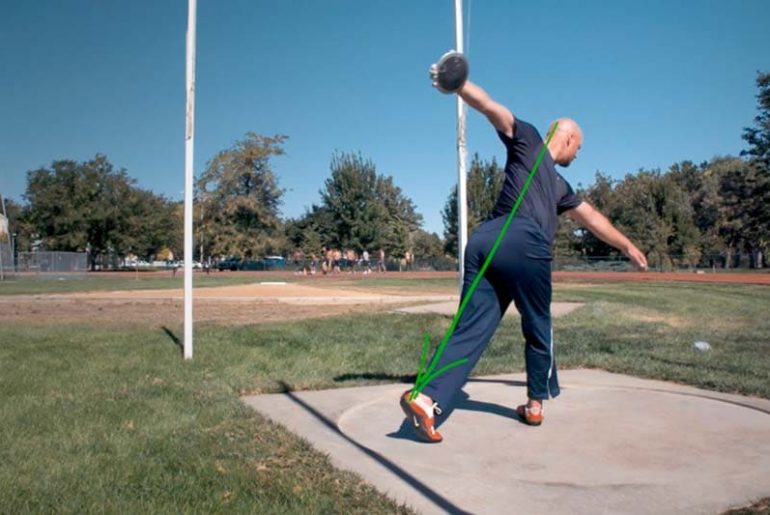Discus throwing is one of the oldest sports in the world, dating back to the 8th century BC. Even in ancient Greece, athletes competed in this discipline with the aim of throwing the discus as far as possible. While the ancient discus discs were made of stone or bronze, today wood or metal cores are used with a metal ring. However, the throwing technique has remained the same, a complex turning technique that you have to carry out exactly, which unfortunately is not easy to learn and, above all, to perfect. Many top discus throwers only reach their best from the age of 30.
Discus throwing has been a discipline at the first Olympic Games since 1896, and women have also been allowed to participate since 1928. Discus throwing is still one of the disciplines of modern athletics in the throw group, alongside hammer throw, javelin throw and shot put.
Rules Discus Throw and Equipment
The aim of this sport is to throw the discus as far as possible. The athlete must remain in a drop zone with a diameter of 2.5 meters. For a powerful release, the athlete takes maximum momentum within the release zone to let the disc come up within the marked landing zone.
With the founding of the International Athletics Federation IAAF in 1912, rules for the discus throw could be recorded in detail for the first time. Today such a competition consists of six attempts and only the best valid distance of an athlete counts. According to the rules for discus throw, the best eight athletes qualify for the three final rounds after three rounds.
Sportswear
Jersey, shorts and sports shoes are common equipment for a discus thrower. The shoes do not have spikes, but a flexible sole that offers good grip on the throwing circle. Slipping can result in a fall and injury. These shoes are usually made of suede or another type of leather.
Diskus
Rules discus throw according to the IAAF rules:
| Women | men | |
| weight | 1 kg | 2kg |
| diameter | 18 cm | 22 cm |
| Height | 3.7 to 3.9 cm | 4.4 to 4.6 cm |
The material can be plastic, wood or rubber without a frame. A competition discus has a steel or brass frame so that the impact does not damage the edges of the disc.
In addition, a discus has a metal insert on both sides in the middle with a diameter of 5 to 5.7 centimeters and a radius of about 0.6 centimeters. Modern devices are often made of carbon fibers or other composite materials and their flight characteristics are optimized with the help of computers.
The mass distribution plays a major role. Most of the mass (between 70 and up to 92 percent) is relocated to the enclosing ring. However, the discus must be symmetrical, the top must not differ from the bottom. The larger the mass fraction in the outer ring, the higher the self-rotation.
The throwing technique
Discus throw technique involves momentum, power, explosiveness at the end of the throw, coordination, and proper flight angle.
A discus throw consists of rotating 1.5 times around its own axis before throwing to accelerate. This fluid-looking rotary movement can be divided into different phases:
Holding the discus with the last phalanges, center of gravity between index and middle fingers. With a slight wrist flexion, the upper edge of the disc touches the forearm.
The starting position for the athlete is with his back to the throwing direction and he stands at the back edge of the circle with his legs a little over shoulder width apart. The arm with the disc hangs loosely at the side of the body.
The swing brings the discus with the throwing arm stretched as far to the right as possible, slightly above shoulder height. The upper body remains upright.
The purpose of the rotation is to accelerate the disc as far as possible by twisting the body. As soon as the front of the body points in the direction of the throw, the left foot lifts off the ground for the flight phase. This creates a movement where the thrower moves forward and spins at the same time.
The landing of the legs before the throw occurs in quick succession and the back of the throwing hand is constantly pointing upwards.
Balanced throwing is important so that the thrower’s power can be fully transferred to the discus. The arm with the discus is still far behind the body until the throw. The upper body is upright, the left side of the body forms a straight line from foot to shoulder. The torsion of the right side of the body and its tension must be maintained and is only released in the release.
The throwing movement is carried out with a long throwing arm at shoulder height. A jump throw briefly has both legs in the air. When throwing, the back of the hand points upwards and the discus rolls over the index finger. The rotation gives the discus flight stability.
In this position, the back leg begins the explosive twist-extend movement that brings the right hip and right shoulder forward. When the body weight comes over the left leg, the pelvis and shoulder axis move in the direction of the throw.
The release is supported by the stretching movement of both legs. For a moment, both legs are in the air during the jump release and the force impulse goes in a straight line in the direction of the throw.
The body momentum is caught during the support throw by jumping over the legs, but only when the device has left the throwing hand. In the jump shot, after leaving the discus, another spin is made in the air to shift the body weight to the center of the ring.
Such a complex process means susceptibility to errors, so every athlete should be mentally strengthened and fully concentrated in the competition.
A good sense of balance and direction are essential in this sport, as is regular exercise.
The playing field
The discus field consists of a throwing circle, a cage and a landing zone. The discus must land in a marked circle sector. Its side borders have an angle of 34.92 degrees and its apex is in the center of the throwing circle.
The Throwing Circle
The throwing circle is 2.5 meters in diameter with a ring that is approximately 0.6 centimeters thick and 0.7 to 0.8 centimeters high. The ring is white and usually made of metal, the base of the throwing circle is made of concrete or a similar non-slip material. On both sides there is a line marking at least 70 centimeters long, perpendicular to the throwing direction. A discus thrower must exit backwards and to the left or right of these lines after the throw. If a thrower touches or crosses a line, the throw is void.
The Litter Cage
Behind and on the sides of the throwing ring is a 4 meter high, solid metal grid or a stretched U-shaped net. This so-called throwing cage is only about 6 meters wide towards the throwing sector. In this way, other people and technical systems are protected from incorrect throws. It can happen that an athlete releases the discus too early or too late and the throwing cage catches the discus.
The landing zone
From the center of the throwing circle, the landing zone extends at a 34.92 degree angle forward of the cage opening for a total of 80 meters. The discus must land in this zone for a valid throw.
Competition procedure
In a regular competition, there are six attempts to throw the discus as far as possible in a given sector. The respective best distance is counted for the respective discus thrower. After the first three attempts, the top eight athletes qualify for the final. In the final there are three throws each and the fourth and fifth attempts are in the reverse order of the standings after the first three attempts. In the final run, the order is rearranged from last to first after the five attempts.
Discus Throw Rules: Invalid throws
A discus throw is considered void if:
- the sportsman leaves the circle after a throw forward
- the upper edge of the throwing ring or the ground outside the circle is touched during the attempt (exception: if the touch occurs without pushing the trigger only during the first turn, it is not a failed attempt)
- the discus does not come up first in the sector
- the preparation time for the throw is exceeded
- the athlete leaves the circle before the disc touches the ground
- the attempt is not started from the rest position.
World records in discus throwing
In the men’s category, a German holds the current world record of 74.08 metres, thrown by Jürgen Schult in 1986. In the women’s category, a German is also undefeated: Gabriele Reinsch holds the world record with 76.8 metres.
The women’s record is therefore a longer distance than that of the men, which is due to the different discus weights.
How does discus throw?
At the reversal point of the discus, both arms are brought to shoulder height as required and the torso and hips are pre-tensioned. The throwing arm is led far to the back (see picture 1). The right foot remains standing and thus slows down the swing.
How heavy is the men’s discus throw?
Men throw at competitions with a 2 kg disc, women with 1 kg. For children and young people there are already models from 0.75 kg.
When is a discus throw illegal?
A discus throw is considered void if:
the sportsman leaves the circle after a throw forward. the upper edge of the throwing ring or the ground outside the circle is touched during the attempt (exception: if the touch occurs without pushing the trigger only during the first turn, it is not a failed attempt)
What is the world record in discus throwing?
Jürgen Schult’s world record since 1986 has been 74.08 m, thrown at the peak of GDR state doping. Harting’s personal best has been 68.37m since throwing gold at the Brazil Games when he crowned himself successor to his brother Robert Harting in the last attempt.
How heavy is an Olympia discus?
The discus throw was a discipline at the first modern Olympic Games in Athens in 1896. At that time, throwing took place from a pedestal measuring 60 by 70 cm. Since 1907 the men have been throwing a circular disc weighing 2 kg and having a diameter of 22 cm. The women’s discus weighs half that.
How far does a discus fly?
If the thrower hurls the discus out of the ring at 25 meters per second – which corresponds to ninety kilometers per hour – this enables him to throw seventy meters.
How is discus throw distance measured?
As can already be seen from the heading, the throwing distance is not determined directly, but indirectly. In addition to a computer, you also need an instrument (electro-optical tachymeter) with which you can measure angles and distances, as well as a reflector (mirrored prism).
How fast does a discus fly?
With a quick one-and-a-half turn, the thrower achieves a throwing speed of the discus of around 25 meters per second. That’s 90 things. About as fast as a gazelle. If you are right-handed, the discus then rotates out of your hand using your index finger and rotates clockwise in flight.





